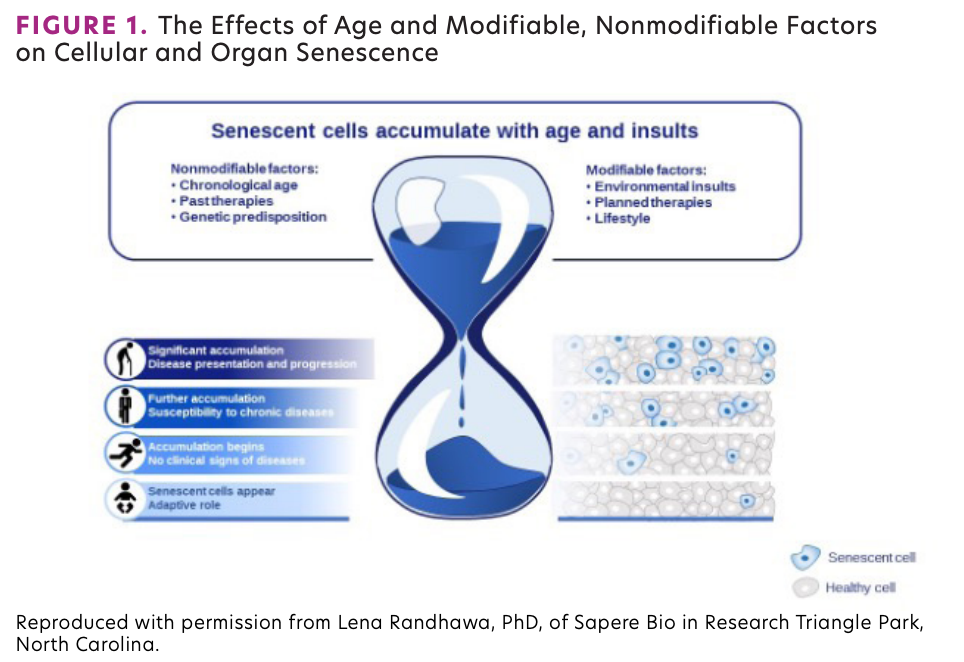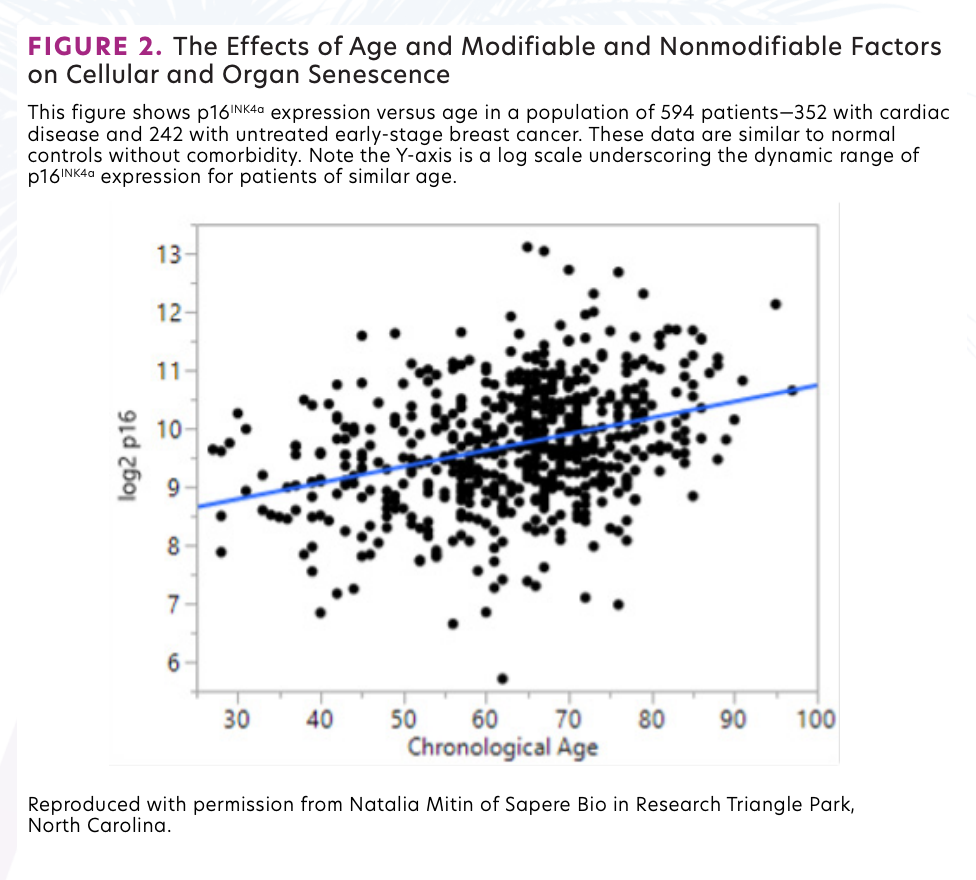Biomarkers Help Predict the Role of Chemotherapy in Biologic Aging
Stimuli for biologic aging include ionizing radiation, ultraviolet light, diet, exercise, oxidative stresses, and perhaps, worst of all, smoking. All of these can trigger intracellular processes, including DNA methylation, or epigenetic change, telomere shortening and damage, DNA damage, and mitochondrial dysfunction.
Hyman B. Muss, MD

Biologic aging is a complex process. There are several theories on why and how we age, and it is probable that none of them account for all the aspects. We are constantly exposed to both internal and external stimuli that, over time, facilitate the aging process. These stimuli include ionizing radiation, ultraviolet light, diet, exercise, oxidative stresses, and perhaps, worst of all, smoking. All of these can trigger intracellular processes, including DNA methylation, or epigenetic change, telomere shortening and damage, DNA damage, and mitochondrial dysfunction. These factors accelerate cellular senescence—what is thought to be the critical factor in aging and has been shown to increase with age.1,2
Cellular senescence is a condition in which a cell has lost the ability to proliferate, and senescent cells increase in almost all organs and tissues as we age. Over time, these changes ultimately lead to the development of significant comorbidities and the cumulative functional deficits we acquire during aging. However, senescent cells are metabolically active and can produce cytokines and inflammatory proteins—the senescence-associated secretory phenotype—further accelerating aging and promoting malignancy. FIGURE 1 illustrates the effect of age and insults on senescence.
Andrew B. Smitherman, MD, MSc

Accumulation of senescent cells is implicated as a cause of tissue reprogramming, osteoporosis, glaucoma, neurodegeneration, type 2 diabetes, changes in the microbiome, immune system dysfunction, dysfunctional tissue repair and fibrosis, and cancer.3 Recent data have shown the potential role of chemotherapy and radiation therapy in accelerating aging. Nowhere is chemotherapy’s effect in accelerating aging more apparent than in children and adolescents treated successfully for childhood malignancy.4 In these patients, by the time they reach aged 35 years, approximately 30% have the clinical phenotype of a person aged 65 years, as evidenced by dramatic increases in cardiac disease and new second malignancies.
At the University of North Carolina Lineberger Comprehensive Cancer Center, we have focused on the effects of chemotherapy and accelerated aging in cancer. To date, we have studied the effects of chemotherapy on childhood cancer, early breast cancer, and bone marrow transplantation. Our research has explored the role of p16INK4a expression, a robust marker of biologic aging, following on the work of Norman E. “Ned” Sharpless, MD, director of the National Cancer Institute. p16INK4a encodes for a protein that blocks cyclin-dependent kinase, analogous to the cyclin-dependent kinase inhibitors now used in breast cancer, including palbociclib (Ibrance), ribociclib (Kisqali), and abemaciclib (Verzenio), that prevent cells from entering the cell cycle.5 This leads to cellular senescence. In murine models, aging is associated with dramatic changes in p16INK4a expression in almost all organs over the animal’s lifespan.6 In human studies, p16INK4a expression is measured in T lymphocytes using a reverse transcription-polymerase chain reaction as a surrogate for aging in other tissues. Studies of p16INK4a expression using other immunohistochemistry methods suggest changes in T cells represent mirror changes in other tissue, and further research in this area is underway.
FIGURE 1. The Effects of Age and Modifiable, Nonmodifiable Factors on Cellular and Organ Senescence

Creating a Roadmap for p16INK4a
The change in p16INK4a with aging is not linear, and after 60 years, it appears to plateau for unclear reasons.7 It is possible that those older persons who would have had high levels of p16INK4a expression have already died of age-related illness such as cardiovascular disease, and current studies are addressing this issue.
The large dynamic range of p16INK4a expression—approximately 10-fold over the human lifespan—makes it an ideal biomarker for study. In healthy children and adolescents, p16INK4a expression is low to undetectable, with high levels appearing in older persons. FIGURE 2 shows the effect of age on p16INK4a expression in 594 patients. These data give p16INK4a expression the potential to be an accurate predictor of cell senescence in an individual patient.
For example, if one hypothesizes that senescent cells are less likely to replicate to ameliorate the adverse effects of chemotherapy (ie, myelosuppression or mucositis), then investigators might be able to accurately predict between 2 patients of the same age—one with high p16INK4a expression and one with low—that the patient with higher expression would have less cellular reserve and be more vulnerable to adverse effects. Studies are underway to determine if p16INK4a expression measured before treatment will prove to be a predictive marker of toxicity for currently used adjuvant chemotherapy regimens.
Investigators have examined several hundred patients with early breast cancer and a smaller number with childhood cancer and after bone marrow transplantation, and they have found that most chemotherapy regimens cause rapid and sustained increases in p16INK4a expression. Changes are seen shortly and dramatically after beginning chemotherapy, persist over time, and are irreversible.5,8,9 In adolescents and young adults treated with chemotherapy, significant increases in p16INK4a expression were associated with frailty and represented a 35-year acceleration in age among frail young adult cancer survivors. These data mimic what has been clinically noted in large study of adults who had childhood cancer: Approximately one-third of young adults and childhood cancer survivors aged 35 years have a disease phenotype of a person aged 65 years.4 Our group has also found that p16INK4a expression rose markedly in patients treated with allogeneic or autologous stem cell transplants for hematologic malignancies. These patients had a 2- to 3-fold increase in p16INK4a expression corresponding to 16 to 28 years of accelerated aging.10
We have noted similar findings in women with early-stage breast cancer. In patients treated with adjuvant or neoadjuvant chemotherapy, especially with anthracycline-based regimens (doxorubicin, cyclophosphamide, and taxanes with or without carboplatin), p16INK4a expression rose dramatically during chemotherapy and persisted during follow-up. On average, chemotherapy accelerated aging by approximately 17 years of life span, with acceleration of 23 to 27 years for those treated with anthracycline-based treatment.
Of note, docetaxel/cyclophosphamide regimens were associated with only 11 years of aging, and we found no evidence that anti-HER2 therapy affected p16INK4a expression. In these studies, accelerated aging due to chemotherapy represents estimates based on the trajectory of p16INK4a expression in normal patients over their lifespan. We are uncertain of the long-term implications of these changes. In our breast cancer studies, baseline p16INK4a expression was also associated with fatigue. In a recent unpublished analysis (Mitin N, et al), the difference between a patient’s baseline p16INK4a expression and a normal value for a patient of the same age—the p16 gap—was highly predictive of chemotherapy-induced peripheral neuropathy with taxane chemotherapy. We also found that baseline p16INK4a expression is a significant predictor of a p16 change, independent of age or chemotherapy type, with those patients having lower baseline p16INK4a expression being more likely to have greater changes with any chemotherapy regimen. The reasons for this are unclear, but patients of similar age with higher p16INK4a less ability to overcome tissue and organ damage. Not all chemotherapeutic agents—for example, taxanes used as a single agent—may be associated with accelerated aging.11 More detailed studies of patients treated with different agents, including immunotherapeutic and other biologic therapies, and for different types of cancer are needed.
FIGURE 2. The Effects of Age and Modifiable and Nonmodifiable Factors on Cellular and Organ Senescence

The Future of p16INK4a
The long-term implications of changes in p16INK4a expression with chemotherapy are unknown, but our data suggest that higher levels may be indicators of frailty, a syndrome associate with increased comorbidity, poor quality of life, and shortened survival. p16INK4a expression has been associated with other diseases of aging, including cardiovascular disease, osteoporosis, and other common illnesses, and our chemotherapy-treated patients with accelerated aging may experience major problems 10 to 20 years after treatment, similar to young adults with cancer, and at a time when they are not likely to be followed by their oncologists.
However, these concerns should not mitigate the use of what has proven to be markedly effective treatment regimens that have dramatically improved overall survival in childhood cancer and breast cancer. It is too early to speculate, especially in breast cancer, whether nonanthracycline regimens with similar effectiveness to anthracyclines may be worth considering for patients with long life expectancy. The use of biomarkers in aging research, “geroscience,” is an exciting area of exploration, and p16INK4a expression is just one of the markers currently being studied.12 The implications of accelerated aging are being studied in other scenarios, and a broad range of studies are exploring interventions to ameliorate biological changes suggesting accelerated aging.
An excellent review of these issues and potential interventions is available13 and describes studies of exercise, diet and nutrition strategies, and senolytics. Learning about the effects of cancer treatment on aging is of major importance, as the clinical scenario of cancer is dominated by older adults who already may have a substantial comorbid illness at the time of diagnosis that might be accelerated by treatment. In children and young adults with cancer, learning how to assess and, in the future, intervene to prevent treatment-related accelerated aging is also a major need.
References
- Campisi J, Kapahi P, Lithgow GJ, Melov S, Newman JC, Verdin E. From discoveries in ageing research to therapeutics for healthy ageing. Nature. 2019;571(7764):183-192. doi:10.1038/s41586-019-1365-2
- Demaria M, O’Leary MN, Chang J, et al. Cellular senescence promotes adverse effects of chemotherapy and cancer relapse. Cancer Discov. 2017;7(2):165-176. doi:10.1158/2159-8290.CD-16-0241
- Calcinotto A, Kohli J, Zagato E, Pellegrini L, Demaria M, Alimonti A. Cellular senescence: aging, cancer, and injury. Physiol Rev. 2019;99(2):1047-1078. doi:10.1152/ physrev.00020.2018
- Smitherman AB, Wood WA, Mitin N, et al. Accelerated aging among childhood, adolescent, and young adult cancer survivors is evidenced by increased expression of p16INK4a and frailty. Cancer. 2020;126(22):4975-4983. doi:10.1002/cncr.33112
- Muss HB, Smitherman A, Wood WA, et al. p16 a biomarker of aging and tolerance for cancer therapy. Transl Cancer Res. 2020;9(9):5732-5742. doi:10.21037/ tcr.2020.03.39
- Liu Y, Sanoff HK, Cho H, et al. Expression of p16(INK4a) in peripheral blood T-cells is a biomarker of human aging. Aging Cell. 2009;8(4):439-448. doi:10.1111/j.1474-9726.2009.00489.x
- Tsygankov D, Liu Y, Sanoff HK, Sharpless NE, Elston TC. A quantitative model for age-dependent expression of the p16INK4a tumor suppressor. Proc Natl Acad Sci U S A. 2009;106(39):16562-16567. doi:10.1073/ pnas.0904405106
- Sanoff HK, Deal AM, Krishnamurthy J, et al. Effect of cytotoxic chemotherapy on markers of molecular age in patients with breast cancer. J Natl Cancer Inst. 2014;106(4):dju057. doi:10.1093/jnci/dju057
- Shachar SS, Deal AM, Reeder-Hayes KE, et al. Effects of breast cancer adjuvant chemotherapy regimens on expression of the aging biomarker, p16INK4a. JNCI Cancer Spectr. 2020;4(6):pkaa082. doi:10.1093/jncics/pkaa082
- Wood WA, Krishnamurthy J, Mitin N, et al. Chemotherapy and stem cell transplantation increase p16INK4a expression, a biomarker of T-cell aging. EBioMedicine. 2016;11:227-238. doi:10.1016/j. ebiom.2016.08.029
- Weiss JM, Pennell N, Deal AM, et al. Nab-paclitaxel in older patients with non-small cell lung cancer who have developed disease progression after platinum-based doublet chemotherapy. Cancer. 2020;126(5):1060-1067. doi:10.1002/cncr.32573
- Ferrucci L, Gonzalez-Freire M, Fabbri E, et al. Measuring biological aging in humans: a quest. Aging Cell. 2019;19(2):e13080. doi:10.1111/acel.13080
- Guida JL, Agurs-Collins T, Ahles TA, et al. Strategies to prevent or remediate cancer and treatment-related aging. J Natl Cancer Inst. 2021;113(2):112-122. doi:10.1093/jnci/djaa060



